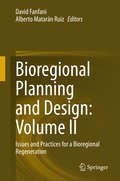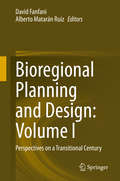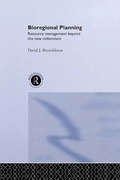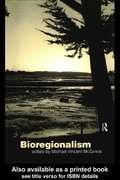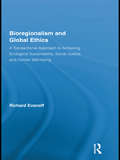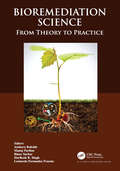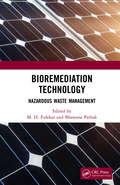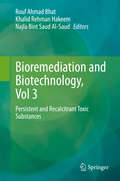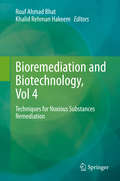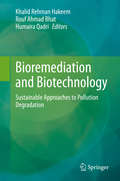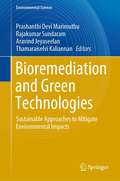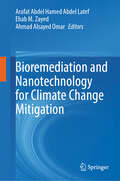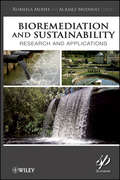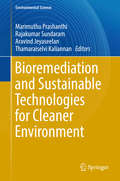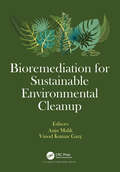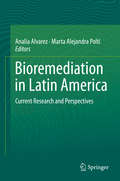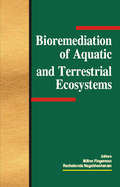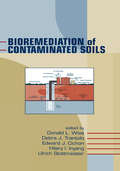- Table View
- List View
Bioregional Planning and Design: Issues and Practices for a Bioregional Regeneration
by David Fanfani Alberto Matarán RuizThis book provides insights and discusses the practical application of the theoretical concept of urban bioregion complementing the general bio-regional planning cross-disciplinary issues provided in Volume I. It examines planning practices, such as relocalisation of energy flows, land protection for climate change, territorial heritage enhancement, the consideration of urban ecosystems and agro-ecology. It presents discussions on regional contexts, practices and projects for a bioregional recovery, and includes case studies from France, Belgium, Spain, Greece, Austria and Italy, discussing topics that range from the reframing of local energy production/delivery planning systems to soil protection and farmland sustainable exploitation schemes. This volume concludes with three cross-European case studies that make clear the worldwide relevance and potential of bioregional approach beyond the Global North or Western countries.
Bioregional Planning and Design: Perspectives on a Transitional Century
by David Fanfani Alberto Matarán RuizThis book provides a review of the bioregionalist theory in the field of spatial planning and design as a suitable approach to cope with the growing concerns about the negative effects of metropolization processes and the need for a sustainable transition. The book starts out with a section on rethinking places for community life, and discusses the reframing of regional governance and development as well as social justice in spatial planning. It introduces the concept of the urban bioregion, a pivotal concept that underpins balanced polycentric spatial patterns and supports self-reliant and fair local development. The second part of the book focuses on planning, and particularly on the issues that arise from the ‘circular’ recovery of the relation between city and agro-ecosystems for integrated planning and resilience of settlements and discusses topics such as foodshed planning, biophilic urbanism and the integration of rural development and spatial planning. This volume sets out the reference framework for Volume II which deals with more specific and operational issues related to spatial policies and settlement design.
Bioregional Planning: Resource Management Beyond the New Millennium
by D J BrunckhorstPresenting a pragmatic mixture of science, landscape ecology, ecosystem management, sociology, policy development and methods for transforming social and institutional cultures. Bioregional Planning: Resource Management Beyond the New Millennium is a timely and practical guide for the analysis, planning and development of bioregional projects for a sustainable future. Significantly, this book presents the strategic actions necessary to plan for, manage and adapt to Ecologically Sustainable Development with a view beyond the new millennium and towards the next. Postgraduates, researchers and policy makers in natural resources management, land planning, sustainable agriculture, rural sciences, ecosystem management and conservation biology will find this book captures the essence of bioregional planning succinctly and makes a compelling argument for why it is a key mechanism in the development of effective governance institutions.
Bioregionalism
by Michael Vincent McGinnisBioregionalism is the first book to explain the theoretical and practical dimensions of bioregionalism from an interdisciplinary standpoint, focusing on the place of bioregional identity within global politics. Leading contributors from a broad range of disciplines introduce this exciting new concept as a framework for thinking about indigenous peoples, local knowledge, globalization, science, global environmental issues, modern society, conservation, history, education and restoration. Bioregionalism's emphasis on place and community radically changes the way we confront human and ecological issues.
Bioregionalism and Global Ethics: A Transactional Approach to Achieving Ecological Sustainability, Social Justice, and Human Well-being
by Richard EvanoffWhile a number of schools of environmental thought — including social ecology, ecofeminism, ecological Marxism, ecoanarchism, and bioregionalism — have attempted to link social issues to a concern for the environment, environmental ethics as an academic discipline has tended to focus more narrowly on ethics related either to changes in personal values or behavior, or to the various ways in which nature might be valued. What is lacking is a framework in which individual, social, and environmental concerns can be looked at not in isolation from each other, but rather in terms of their interrelationships. In this book, Evanoff aims to develop just such a philosophical framework — one in which ethical questions related to interactions between self, society, and nature can be discussed across disciplines and from a variety of different perspectives. The central problem his study investigates is the extent to which a dichotomized view of the relationship between nature and culture, perpetuated in ongoing debates over anthropocentric vs. ecocentric approaches to environmental ethics, might be overcome through the adoption of a transactional perspective, which offers a more dynamic and coevolutionary understanding of how humans interact with their natural environments. Unlike anthropocentric approaches to environmental ethics, which often privilege human concerns over ecological preservation, and some ecocentric approaches, which place more emphasis on preserving natural environments than on meeting human needs, a transactional approach attempts to create more symbiotic and less conflictual modes of interaction between human cultures and natural environments, which allow for the flourishing of both.
Bioregulatory Medicine: An Innovative Holistic Approach to Self-Healing
by Jess Higgins Kelley Dickson Thom James Paul Odell Jeoffrey Drobot Frank PleusOver half of the world&’s population is afflicted with some form of chronic or degenerative illness. Heart disease, autoimmune disease, diabetes, neurological conditions, cancer, Lyme disease—the list goes on. The conventional, allopathic, treat-the-symptom-with-pharmaceutical-drugs model is rapidly falling out of favor as patients are searching for nontoxic, advanced prevention and healing modalities that actually work. Bioregulatory Medicine introduces a model that has proven effective for decades in other more forward-thinking developed countries, including Switzerland and Germany.Our bodies have many bioregulating systems, including the cardiovascular, digestive, neurological, respiratory, endocrine, and so on. Bioregulatory medicine is a comprehensive and holistic approach to health that advocates the use of natural healing methods to support and restore the body&’s intrinsic self-regulating and self-healing mechanisms, as opposed to simply treating symptoms with integrative therapies. Bioregulatory medicine is about discovering the root cause of disease and takes into account the entire person from a genetic, epigenetic, metabolic, energetic, and emotional point of view. So while patients may have the same disease or prognosis, the manifestation of illness is entirely bioindividual and must be treated and prevented on an individual level.Bioregulatory Medicine addresses the four pillars of health—drainage and detox, diet, mind-body medicine, and oral health—using a sophisticated synthesis of the very best natural medicine with modern advances in technology. In addition to identifying the cause of disease, bioregulatory medicine promotes disease prevention and early intervention of illness through noninvasive diagnostics and treatments, and incorporates the use of over 100 different non-toxic diagnostics and treatments from around the world.Forward-thinking patients and integrative practitioners will find Bioregulatory Medicine invaluable as they seek to deepen their understanding of the body&’s many regulating systems and innate ability to heal itself.
Bioremediation Protocols (Methods in Biotechnology #2)
by David SheehanLeading researchers from around the world present their best genetic, chemical, and analytical techniques for studying specific pollutants and their remediation. Their expert procedures range widely from cell immobilization and screening to microbiological and analytical chemistry methods that are applied to such environmental pollutants as hydrocarbons, PAHs, PCBs, TBT, and heavy metals. These pathbreaking contributors have also included illuminating reviews and case studies intended to expand the useful range of the methods, and they discuss such major issues in bioremediation as the design and use of bioreactors, genetic manipulation, and the preparation and analysis of environmental samples.
Bioremediation Science: From Theory to Practice
by Amitava Rakshit, Manoj Parihar, Binoy Sarkar, Harikesh B. Singh and Leonardo Fernandes FracetoThis book provides state of the art description of various approaches, techniques and some basic fundamentals of bioremediation to manage a variety of organic and inorganic wastes and pollutants present in our environment. A comprehensive overview of recent advances and new development in the field of bioremediation research are provided within relevant theoretical framework to improve our understanding for the cleaning up of polluted water and contaminated land. The book is easy to read and language can be readily comprehended by aspiring newcomer, students, researchers and anyone else interested in this field. Renowned scientists around the world working on the above topics have contributed chapters. In this edited book, we have addressed the scope of the inexpensive and energy neutral bioremediation technologies. The scope of the book extends to environmental/agricultural scientists, students, consultants, site owners, industrial stakeholders, regulators and policy makers.
Bioremediation Technology for Plastic Waste
by Mohd. Shahnawaz Manisha K. Sangale Avinash B. AdePlastic is one of the widely used polymers around the globe since its discovery. It is highly impossible to think the ease of life without the aid of plastic. Every year billion tons of plastic waste gets accumulated in the environment and leads to death of both marine and terrestrial animals. Plastic is very durable and needs around 1000 years to degrade under the natural environment. The present book illustrates the importance and significance of the bioremediation to tackle the problem of plastic waste. Previously, we have reported elite rhizobacterial isolates (Lysinibacillus fusiformis strain VASB14/WL and Bacillus cereus strain VASB1/TS) of Avicennia marina Vierh (Forsk.) from the West Coast of India with the potential to degrade plastic (polythene). The present book attempted to address the bioremediation scenario of plastic waste (including micro plastic) using microbes with bacteria in particular. Various strategies used to tackle with the plastic waste were highlighted with case studies of plastic waste management, including in vitro, in situ and ex situ with a special reference to biodegradation technology. After the biodegradation of the plastic using microbes, the generated plastic (polythene) degradation products (PE-DPs) were also documented using GC-MS technique followed by their deleterious effect on both animal and plant systems. The book also enhances the awareness of the plastic-free society and also suggests some alternative materials to be used instead of plastic. Lastly, the book suggests/recommends the strategies to be followed by the lawmakers in the government organizations/non-government organizations/social organizations to frame the regulations and guidelines to implement at mass level to reduce the generation of plastic waste.
Bioremediation Technology: Hazardous Waste Management
by M. H. Fulekar Bhawana PathakThe book describes hazardous waste industries, sources of waste generation, characterization and treatment processes/ methods and technique and technology to deal with the treated waste as per the prescribed standard. Advanced treatment based on the microbial remediation, plant-based decontamination, rhizoremediation and nano-based remediation is also explained. Advances in treatment technology using biotechnological tools/bionanotechnology for removal of contaminants are described. This volume will help readers to develop biotechnological and nanotechnological approaches for the remediation of hazardous waste and the developed technology that can be transferred from laboratory to land and piloting to commercial scenarios. Prof. M. H. Fulekar a Professor and Joint Director (R&D), Centre of Research for Development, Parul University. Dr. Bhawana Pathak is working as an Associate Professor and Dean in School of Environment and Sustainable Development, Central University of Gujarat.
Bioremediation and Biotechnology, Vol 2: Degradation of Pesticides and Heavy Metals
by Khalid Rehman Hakeem Rouf Ahmad Bhat Moonisa Aslam DervashThis book addresses the grave concerns stemming out due to conventional treatment techniques. The main focus of this book revolves round the central kernel of novel technology (bioremediation and biotechnology) which has emerged as an independent warrior to clean up and restore the disturbed environs. Furthermore, this book is a coherent assortment of diverse chapters relevant to the role of biotechnology and bioremediation for restoration of the ecosystems degraded by pesticide and heavy metal pollution. The inaugural chapters deal with the quantification of problem and its magnitude due to pesticides and heavy metals, followed by innovative modern biotechnological and bioremediation treatment technologies and sustainable techniques to remediate the persistent pollutants. It is a detailed comprehensive account for the treatment technologies from unsustainable to sustainable. Academicians, researchers and students shall find it as a complete wrap up regarding biotechnological intervention for sustainable treatment of pollution and shall suffice for the diverse needs of teaching and research.
Bioremediation and Biotechnology, Vol 3: Persistent and Recalcitrant Toxic Substances
by Khalid Rehman Hakeem Rouf Ahmad Bhat Najla Bint Saud Al-SaudHealthy environment is important for any kind of biota on earth. It provides the basic elements of life such as clean water, fresh air, fertile soil and supports ecosystem of the food chain. Pollution drastically alters quality of the environment by changing the physico-chemical and biological aspects of these components. Accordingly, toxic metals, combustible and putrescible substances, hazardous wastes, explosives and petroleum products are all examples of inorganic and organic compounds that cause contaminations. Specifically, pollution of toxic and heavy metal in the environment is a growing problem worldwide, currently at an alarming rate. Toxic metals threaten the aquatic ecosystems, agriculture and ultimately human health. Traditional treatment techniques offer certain advantages such as rapid processing, ease of operation and control and flexibility. But, they could not maintain the quality of the environment due to the high operational costs of chemicals used, high energy consumption and handling costs for sludge disposal and overburden of chemical substances which irreversibly affect and destroy biodiversity, which ultimately render the soil useless as a medium for plant growth. Therefore, bioremediation and biotechnology, carried out by living assets to clean up, stabilize and restore contaminated ecosystems, have emerged as promising, environmental friendly and affordable approaches. Furthermore, the use of microbes, algae, transgenic plants and weeds adapted to stressful environments could be employed to enhance accumulation efficiency. Hence, sustainable and inexpensive processes are fast emerging as a viable alternative to conventional remediation methods, and will be most suitable for developing countries.In the current volume, we discuss pollution remediation challenges and how living organisms and the latest biotechnological techniques could be helpful in remediating the pollution in ecofriendly and sustainable ways.
Bioremediation and Biotechnology, Vol 4: Techniques for Noxious Substances Remediation
by Khalid Rehman Hakeem Rouf Ahmad BhatThe rapid thriving of industries, conversion of agricultural land to residential areas, habitat destruction, deforestation and use of recalcitrant synthetic substances enhanced the rate of degradation of the environment. Although there are various conventional techniques for degradation and cleaning of noxious pollutants from disturbed environs, they are energy inefficient and costly to install. Bioremediation has emerged recently as an alternative and novel approach to manage and control environmental pollutants. This volume focuses explicitly on the remediation of noxious substances in stressed environs. It includes expert-contributed chapters on bio-monitoring by way of evaluating the relationship of biota with the polluted/stressed environs, sustainable plant-based degradation of noxious pollutants, and the application of biotechnologies to achieve tailored responses.Academicians, researchers, scientists and students will find this work essential for sustainable treatment of noxious pollutants. This book also serves as a core guide for training, teaching and research in conservation biology and environmental rehabilitation.
Bioremediation and Biotechnology: Sustainable Approaches to Pollution Degradation
by Khalid Rehman Hakeem Humaira Qadri Rouf Ahmad BhatToxic substances threatens aquatic and terrestrial ecosystems and ultimately human health. The book is a thoughtful effort in bringing forth the role of biotechnology for bioremediation and restoration of the ecosystems degraded by toxic and heavy metal pollution. The introductory chapters of the book deal with the understanding of the issues concerned with the pollution caused by toxic elements and heavy metals and their impacts on the different ecosystems followed by the techniques involved in monitoring of the pollution. These techniques include use of bio-indicators as well as modern techniques for the assessment and monitoring of toxicants in the environment. Detailed chapters discussing the role of microbial biota, aquatic plants, terrestrial plants to enhance the accumulation efficiency of these toxic and heavy metals are followed by remediation techniques involving myco-remediation, bio-pesticides, bio-fertilizers, phyto-remediation and rhizo-filtration. A sizable portion of the book has been dedicated to the advanced bio-remediation techniques which are finding their way from the laboratory to the field for revival of the degraded ecosystems. These involve bio-films, micro-algae, genetically modified plants and filter feeders. Furthermore, the book is a detailed comprehensive account for the treatment technologies from unsustainable to sustainable. We believe academicians, researchers and students will find this book informative as a complete reference for biotechnological intervention for sustainable treatment of pollution.
Bioremediation and Green Technologies: Sustainable Approaches to Mitigate Environmental Impacts (Environmental Science and Engineering)
by Rajakumar Sundaram Aravind Jeyaseelan Thamaraiselvi Kaliannan Prashanthi Devi MarimuthuThis book offers insights into the recent research focusing on green solutions to address environmental pollution and its impacts. Bioremediation is a vast area that encompasses numerous innovative and cost-effective experimental and research methods involvingnumerous technologies, such as biotechnological, biochemical, microbial, marine, chemical and engineering approaches. Featuring original research and review articles by leading experts, the book explores potential solutions to the growing issues of waste management and environmental pollution and their impacts, and suggests future research directions. As such, it is a valuable resource for professionals and general readers alike.
Bioremediation and Nanotechnology for Climate Change Mitigation
by Arafat Abdel Hamed Abdel Latef Ehab M. Zayed Ahmad Alsayed OmarThis book integrates various scientific approaches, including bioremediation and nanomaterials, to address environmental challenges posed by living organisms. It serves as a crucial guide for decision-makers, providing a scientific foundation for tackling issues within the circular economy paradigm. By introducing innovative methods for improving environmental conditions, the book facilitates the design of eco-friendly cities and revitalizes older urban areas. The chapters cover topics such as the current state and future of international environmental relations, the impact of population growth on pollution, and recent advances in sustainable waste management. Readers will discover insights into the relationship between air pollution, nanomaterials, and bioremediation, as well as the role of artificial intelligence as a predictive tool. The book also explores key pollution-related issues and presents effective remediation strategies. Special attention is given to the role of nanotechnology in addressing climate change, with chapters highlighting its applications in sustainable agriculture. This book is an invaluable resource for professionals, researchers, and graduate students engaged in advanced environmental science research. It reinforces fundamental remediation concepts while introducing the latest updates, maximizing readers' knowledge of sensor-based remediation. The book presents a multidisciplinary approach, integrating theoretical perspectives with practical case studies. Whether the reader is an academic, practitioner, or interested layperson, this book offers a wealth of information and insights into the future of environmental sustainability.
Bioremediation and Sustainability: Research and Applications
by Ackmez Mudhoo Romeela MoheeBioremediation and Sustainability is an up-to-date and comprehensive treatment of research and applications for some of the most important low-cost, "green," emerging technologies in chemical and environmental engineering.
Bioremediation and Sustainable Technologies for Cleaner Environment (Environmental Science and Engineering)
by Marimuthu Prashanthi Rajakumar Sundaram Aravind Jeyaseelan Thamaraiselvi KaliannanThis book offers insights into the current focus and recent advances in bioremediation and green technology applications for waste minimization and pollution control. Increasing urbanization has an impact on the environment, agriculture and industry, exacerbating the pollution problem and creating an urgent need for sustainable and green eco-friendly remediation technology. Currently, there is heightened interest in environmental research, especially in the area of pollution remediation and waste conversion, and alternative, eco-friendly methods involving better usage of agricultural residues as economically viable substrates for environmental cleanup are still required. The book offers researchers and scholars inspiration, and suggests directions for specific waste management and pollution control. The research presented makes a valuable contribution toward a sustainable and eco-friendly societal environment.
Bioremediation for Sustainable Environmental Cleanup
by Vinod Kumar Garg Anju MalikThe present book, Bioremediation for Sustainable Environmental Cleanup, has a compilation of seventeen chapters comprehensively describing the state-of-the-art on emerging bioremediation approaches employed for sustainable environmental clean-up of diverse environmental pollutants such as metal(loid)s, polycyclic aromatic hydrocarbons, dyes, pesticides, petroleum hydrocarbons, etc., by using bacteria, fungi, algae, higher plants, and novel materials like biohybrids, nano-biomaterials, and graphitic carbon nitride (g-C3N4). Different bioremediation strategies such as biosorption, bioprecipitation, bioaccumulation, biodegradation, biotransformation etc. have been described in detail. The emphasis throughout, however, is on sustainable environmental clean-up. Eminent researchers from various countries located in diverse geographical areas, including Argentina, Canada, Germany, India, Pakistan, South Africa, the United Kingdom, and the United States of America, have contributed towards the chapters of this book.
Bioremediation in Latin America: Current Research and Perspectives
by Analía Alvarez Marta Alejandra PoltiThe book compiles an update information about the state of bioremediation in emerging Latin American countries. Some of the studied regions are sites that suffered decades of pollution by agrochemicals, heavy metals and industrial waste due to the lack of control by government regulations. Such is the case of Northern Argentina, where were illegally deposited over 30 tn of obsolete organochlorine pesticides in 1994. The content has focused in the use of native organisms (from bacteria to plants) as a viable solution to the problem of pollution, using low-cost and powerful techniques, socially well accepted and appropriate from the environmental point of view. In this context, levels of pesticide found in the Latin American population are informed. It was also displayed as a multidisciplinary approach based on concerns of a diverse group of researchers (biochemists, biologists, chemical engineers and geneticists) about a global problem, dealing with specific cases of study, with a view to project their findings to worldwide. In this regard, researchers provide their findings to regulatory sectors, whom could make appropriate decisions.
Bioremediation of Agricultural Soils
by Juan C. Sanchez-HernandezThe quality of agricultural soils are always under threat from chemical contaminants, which ultimately affect the productivity and safety of crops. Besides agrochemicals, a new generation of substances invades the soil through irrigation with reclaimed wastewater and pollutants of organic origin such as sewage sludge or cattle manure. Emerging pollutants such as pharmaceuticals, nanomaterials and microplastics are now present in agricultural soils, but the understanding of their impact on soil quality is still limited. With focus on in situ bioremediation, this book provides an exhaustive analysis of the current biological methodologies for recovering polluted agricultural soils as well as monitoring the effectiveness of bioremediation.
Bioremediation of Aquatic and Terrestrial Ecosystems
by Milton FingermanBioremediation, the use of microorganisms to degrade, sequester, or remove environmental contaminants, is an urgent need of our planet for protection and restoration from toxic contaminants. This book not only provides cutting edge information about bioremediation of aquatic and terrestrial habitats, but also highlights the gaps in our knowledge of
Bioremediation of Contaminated Soils (Environmental Science & Pollution)
by Donald L. WiseThis volume focuses on innovative bioremediation techniques and applications for the cleanup of contaminated media and sites. It includes quantitative and design methods that elucidate the relationships among various operational parameters, and waste chemistry that defines the cost effectiveness of bioremediation projects. It also presents numerica
Bioremediation of Environmental Pollutants: Emerging Trends and Strategies
by Ravindra Soni Deep Chandra SuyalThis book collates the latest trends and technological advancements in bioremediation, especially for its monitoring and assessment.Divided into 18 chapters, the book summarizes basic concepts of waste management and bioremediation, describes advancements of the existing technologies, and highlights the role of modern instrumentation and analytical methods, for environmental clean-up and sustainability.The chapters cover topics such as the role of microbial fuel cells in waste management, microbial biosensors for real-time monitoring of bioremediation processes, genetically modified microorganisms for bioremediation, application of immobilized enzyme reactors, spectroscopic techniques, and in-silico approaches in bioremediation monitoring and assessment. The book will be advantageous not only to researchers and scholars interested in bioremediation and sustainability but also to professionals and policymakers.
Bioremediation of Environmental Toxicants: Toxicants, Sources, Mechanism, Impact on Human Health, and Bioremediation Approaches
by Kumud Kant Awasthi Mahipal Singh Sankhla Chandra Shekhar YadavBioremediation of Environmental Toxicants: Toxicants, Sources, Mechanism, Impact on Human Health, and Bioremediation Approaches provides insight into the nature of environmental toxicants, the impact on human health, and their bioremediation approaches, viz. nanotechnology, microorganism, and phytoremediation. Various environmental toxicants such as pesticides, heavy metals, plastic and microplastic waste, dyes used in industries, colorants, corrosive agents, and biomedical waste show different levels of mechanism of toxicity, possessing a significant threat to human health as well as the stability of ecosystems. To decontaminate the environment from these toxic compounds a low-cost effective technique is required. Bioremediation is a sustainable approach by which hazardous pollutants are converted into less harmful or non-toxic compounds using effective techniques to detoxify contaminated soil and water. In recent years, research has steadily concentrated on the various bioremediation approaches, viz. nanoparticle, microorganism, and phytoremediation.KEY FEATURES Showcases contributions from high-profile experts in the field Highlights the current state and importance of environmental bioremediation Provides detailed knowledge about the mechanism, toxicity, and action of environmental toxicants Furnishes a deep understanding of environment–human interaction and the after effects Outlines the state-of-the-art bioremediation technologies, viz. nanotechnology, microbial- and plant-based mitigation of environmental toxicants
